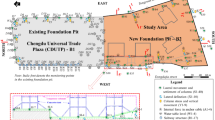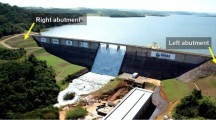Abstract
The aim of this study is to investigate the coupling effects of re-excavation and hydraulic uplift on base instability of pit-in-pit (PIP) braced excavations. The numerical model of PIP braced excavation in Shanghai soft clay overlying a confined aquifer was established by upper-bound finite element limit analysis (UBFELA) method. The effects of the sensitive design parameters (i.e., the artesian pressure, thickness and undrained shear strength of the aquitard and excavation width of inner pit) on failure mechanisms and upper-bound safety factor (FS) against hydraulic uplift were analyzed. The results show that the value of FS increases with an increase in the thickness and undrained shear strength of the aquitard, but decreases with increasing the artesian pressure and excavation width of inner pit. The failure modes can be typically classified into three categories: circular slip surface in outer pit (M1), hydraulic uplift combined with circular slip surface in entire PIP system (M2), and basal hydraulic uplift in inner pit (M3); then the corresponding critical artesian pressure is determined. Finally, the average value of critical artesian pressure used to distinguish the three types of failure modes is recommended as the design value against hydraulic uplift in the PIP system, and validity is verified by the comparison with the current design methods. The proposed stability design by UBFELA contributes to ensure the serviceability and performance of PIP system.
Similar content being viewed by others
Abbreviations
- b :
-
Excavation width of inner pit (m)
- B :
-
Excavation width of outer pit (m)
- c :
-
Cohesion (kPa)
- d :
-
Insertion length of inner wall (m)
- D :
-
Insertion length of outer wall (m)
- E :
-
Modulus of elasticity of diaphragm wall (kPa)
- E s :
-
Modulus of elasticity of steel (kPa)
- E ur ref :
-
Elastic unloading/reloading (kPa)
- E 50 ref :
-
Plastic straining due to primary deviatoric loading (kPa)
- h :
-
Depth of inner pit (m)
- H :
-
Depth of outer pit (m)
- H a :
-
Thickness of aquitard (m)
- h i :
-
Thickness of different strata of soil (m)
- h s :
-
Height of the top of confined aquifer (m)
- h w :
-
Height of hydraulic head (m)
- I s :
-
Inertia moment of steel (m4)
- K x :
-
Horizontal coefficient of permeability (m/d)
- K y :
-
Vertical coefficient of permeability (m/d)
- m :
-
Power exponent related stress level
- P :
-
Artesian pressure (kPa)
- P cr :
-
Critical hydraulic pressure (kPa)
- P cr1 :
-
Initial artesian pressure (kPa)
- P cr2 :
-
Average value of Initial and endmost artesian pressure (kPa)
- P cr3 :
-
Endmost artesian pressure (kPa)
- p ref :
-
Reference pressure (kPa)
- R inter :
-
Strength reduction factor
- S u :
-
Undrained shear strength (kPa)
- t :
-
Thickness of diaphragm wall (m)
- W :
-
Calculation length of diaphragm wall (m)
- α :
-
Improving coefficient of stiffness
- γ :
-
Unit weight of soil (kN/m3)
- γ w :
-
Unit weight of water (kN/m3)
- υ :
-
Poisson’s ratio
- ϕ :
-
Internal friction angle (°)
References
Ciria H, Peraire J, Bonet J (2008) Mesh adaptive computation of upper and lower bounds in limit analysis. International Journal for Numerical Methods in Engineering 75(8):899–944, DOI: 10.1002/nme.2275
Ding CL, Li ZQ, Wu XP, Wu KL (2014) Analysis on inducing factors to inrushing plastic deformation failure of foundation pit with confined water. Geo-Shanghai, Shanghai, China, 491–501
Do TN, Ou CY, Lim A (2013) Evaluation of factors of safety against basal heave for deep excavations in soft clay using the finite-element method. Journal of Geotechnical and Geoenvironmental Engineering 139(12):2125–2135, DOI: 10.1061/(ASCE)GT.1943-5606.0000940
Giampa JR, Bradshaw AS, Schneider JA (2017) Influence of dilation angle on drained shallow circular anchor uplift capacity. International Journal of Geomechanics 17(2):04016056, DOI: 10.1061/(ASCE)GM.1943-5622.0000725
Hong Y, Wang LZ (2016) Deformation and failure mechanism of excavation in clay subjected to hydraulic uplift. Springer, Berlin, Germany
Hu Y, Li YA, Li B, Li CA, Xiao JF (2018) Centrifugal model test and numerical simulation of three-dimensional space effect of deep and large foundation pit under the confined water level fluctuation. Rock and soil Mechanics 39(06):1999–2007
Huang MS, Du ZL, Song CX (2011) Effects of inserted depth of wall penetration on basal stability of foundation pits in clay. Chinese Journal of Geotechnical Engineering 33(07):1097–1103 (in Chinese)
Keawsawasvong S, Ukritchon B (2019) Undrained basal stability of braced circular excavations in non-homogeneous clays with linear increase of strength with depth. Computers and Geotechnics, 115:103180, DOI: 10.1016/j.compgeo.2019.103180
Krabbenhoft K, Lyamin A, Krabbenhoft J (2015) Optum computational engineering (optumG2). Optum, https://www.optumce.com
Li T, Wang C (2009) Bottom heave stability during foundation pit excavation in soft layer with high artesian water pressure. Chinese Journal of Geotechnical Engineering 31(08):1236–1241 (in Chinese)
Liang YR (1996) Analysis of strip pit inrushing. Chinese Journal of Geotechical Engineering 18(01):75–79 (in Chinese)
Longworth TI, Moore JFA (1979) Hydraulic uplift of the base of a deep excavation in Oxford Clay. Géotechnique 29(1):35–46, DOI: 10.1680/geot.1979.29.1.35
Martin CM (2011) The use of adaptive finite-element limit analysis to reveal slip-line fields. Géotechnique Letters 1(2):23–29, DOI: 10.1680/geolett.11.00018
Milligan V, Lo KY (1970) Observations on some basal failures in sheeted excavations. Canadian Geotechnical Journal 7(2):136–144, DOI: 10.1139/t70-017
Roy D, Robinson KE (2009) Surface settlements at a soft soil site due to bedrock dewatering. Engineering Geology 107(3):109–117, DOI: 10.1016/j.enggeo.2009.05.006
Sloan SW (2013) Geotechnical stability analysis. Geotechnique 63(7):531–572, DOI: 10.1680/geot.12.RL.001
Sloan SW, Kleeman PW (1995) Upper bound limit analysis using discontinuous velocity fields. Computer Methods in Applied Mechanics and Engineering 127(1):293–314, DOI: 10.1016/0045-7825(95)00868-1
Sun YY (2016) Experimental and theoretical investigation on the stability of deep excavations against confined aquifers in Shanghai, China. KSCE Journal of Civil Engineering 20(11):2746–2754, DOI: 10.1007/s12205-016-0488-3
Sun Y, Zhou S, Luo Z (2017) Basal-heave analysis of pit-in-pit braced excavations in soft clays. Computers and Geotechnics 81:294–306, DOI: 10.1016/j.compgeo.2016.09.003
Tan Y, Lu Y, Xu C, Wang D (2018) Investigation on performance of a large circular pit-in-pit excavation in clay-gravel-cobble mixed strata. Tunnelling and Underground Space Technology 79:356–374, DOI: 10.1016/j.tust.2018.06.023
Tang C, Toh KC, Phoon, KK (2014) Axisymmetric lower-bound limit analysis using finite elements and second-order cone programming. Journal of Engineering Mechanics 140(2):268–278, DOI: 10.1061/(asce)em.1943-7889.0000669
Terzaghi K, Peck RB (1968) Soil mechanics in engineering practice. John Wiley & Sons, New York, NY, USA
Ukritchon B, Keawsawasvong S (2018) A new design equation for drained stability of conical slopes in cohesive-frictional soils. Journal of Rock Mechanics and Geotechnical Engineering 10(2):358–366, DOI: 10.1016/j.jrmge.2017.10.004
Ukritchon B, Whittle AJ, Sloan SW (2003) Undrained stability of braced excavations in clay. Journal of Geotechnical and Geoenvironmental Engineering 129(8):738–755, DOI: 10.1061/(ASCE)1090-0241(2003)129:8(738)
Wang J, Feng B, Yu H, Guo T, Yang G, Tang J (2013) Numerical study of dewatering in a large deep foundation pit. Environmental Earth Sciences 69(3):863–872, DOI: 10.1007/s12665-012-1972-9
Wang Y, Li B, Chen C, Jia H (2019) Influence of groundwater level fluctuation on lateral deformation of cantilever enclosure structure of pit-in-pit. Marine Georesources & Geotechnology 38:108–113, DOI: 10.1080/1064119x.2018.1558471
Wang J, Liu X, Liu J, Wu L, Guo Q, Yang Q (2018) Dewatering of a 32.55 m deep foundation pit in MAMA under leakage risk conditions. KSCE Journal of Civil Engineering 22(8):2784–2801, DOI: 10.1007/s12205-017-1950-6
Xu YS, Shen SL, Du YJ (2009) Geological and hydrogeological environment in Shanghai with geohazards to construction and maintenance of infrastructures. Engineering Geology 109(3–4):241–254, DOI: 10.1016/j.enggeo.2009.08.009
Yang JM, Zheng G (2009) Classification of seepage failures and opinion to formula for check bursting instability indewatering. Rock and soil Mechanics 30(01):261–264 (in Chinese)
Zhang YQ, Li MG, Wang JH, Chen JJ, Zhu YF (2017a) Field tests of pumping-recharge technology for deep confined aquifers and its application to a deep excavation. Engineering Geology 228:249–259, DOI: 10.1016/j.enggeo.2017.08.019
Zhang YQ, Wang JH, Chen JJ, Li MG (2017b) Numerical study on the responses of groundwater and strata to pumping and recharge in a deep confined aquifer. Journal of Hydrology 548:342–352, DOI: 10.1016/j.jhydrol.2017.03.018
Zhang YQ, Wang JH, Li MG (2018) Effect of dewatering in a confined aquifer on ground settlement in deep excavations. International Journal of Geomechanics 18(10):04018120, DOI: 10.1061/(ASCE)GM.1943-5622.0001233
Zhou J, Zhang G, Hu, ZF (2006) Model test reserch on judgment method of water gushing in pit. Chinese Journal of Rock Mechanics and Engineering 25(10):2115–2120 (in Chinese)
Acknowledgements
This study is financially supported by the National Natural Science Foundation of China (Grant No.41572253).
Author information
Authors and Affiliations
Corresponding author
Rights and permissions
About this article
Cite this article
Chen, F., Miao, G. & Lai, F. Base Instability Triggered by Hydraulic Uplift of Pit-in-Pit Braced Excavations in Soft Clay Overlying a Confined Aquifer. KSCE J Civ Eng 24, 1717–1730 (2020). https://doi.org/10.1007/s12205-020-1102-2
Received:
Revised:
Accepted:
Published:
Issue Date:
DOI: https://doi.org/10.1007/s12205-020-1102-2




